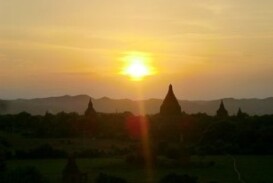Kipling and Orwell are perhaps the most famous travellers to Myanmar (Burma), but it is an earlier visitor who remains most influential. The Lord Buddha is said to have passed through here sometime between 500-550BC, and the stories of his journeys are reflected in the many cities, pagodas and golden statues you will see on your visit.
I joined that illustrious group last year when Griff from Peregrine Adventures asked me to join a group he was escorting. I had to think for all of ½ a second before I said yes.
As our aircraft descended into Yangon (Rangoon), I had to admit I was a little apprehensive as to what I would find. I had heard stories of an oppressive regime and a country that was only just opening up reluctantly to visitors. How wrong I was – Myanmar should also be called the land of smiles! Customs and Immigration in many other countries should take heed of how we were WELCOMED into Myanmar – and that theme was to continue for the next two weeks.
The only military presence I saw was when we pulled up at a set of lights next to an army truck. I did my best to avoid eye contact – as you do – but couldn’t help myself. But when I turned to have a look, a sea of smiling faces greeted me.
In keeping with the way Peregrine operates, most of our meals were eaten outside our hotels and at local restaurants. We would walk down some back street and always end up eating a meal fit for a King – or a Queen. Lots of great food…..and then we would end up in front of the lens for a change being photographed by the curious locals.

My highlights were:
Walking around the Shwedagon Pagoda at night in a light rain accompanied by the local novice monks, who were dressed in saffron robes, sandals and carrying the ubiquitous smart phone, whilst explaining the workings of the temple. This structure is covered in 6-60 tonnes of gold depending on who you listen to – and lit up at night putting other so called icons like the Eiffel tower to shame.
A day spent biking around the many hundreds of temples in Pagan, and then in the late evening climbing to the top of one of the highest to watch the sunset over this magical part of the world. There were hundreds of people present and I swear you could have heard a pin drop as the sun dipped below the horizon.

We spent two days on Inle lake, where whole communities live, go to school, grow food, and trade. We visited blacksmith shops, weaving and art studios, restaurants, silk factories, not to mention the Jumping Cat Monastery - all perched above the water, and even crashed the local Farmers Market on a Saturday morning. Here you paddle down ever narrowing creeks to buy/sell your produce – some of which is still taken away by ox-cart.

A real highlight of the trip was when two of us insomniacs got up at 5:00 am and went for a walk to watch this part of the world wake up - once in Yangon, and then again in a remote village with just the chooks, dogs and pigs for company as we looked on while fisherman set out for their days work. The sights and sounds of rural Myanmar waking up is something that will stay in my memory for some time. In our ignorance, we were probably wandering through people’s back yards, but without fail we would be greeted by a big smile and a wave. How many of us would do the same if the positions were reversed?
In summary, I guess Myanmar today is a bit like Vietnam was when I first visited there some years ago. Now would probably be one of the best times to go – the infrastructure for tourism is good enough to give you a wonderful, relaxed holiday – but the country is yet to be spoilt by exploitation.
